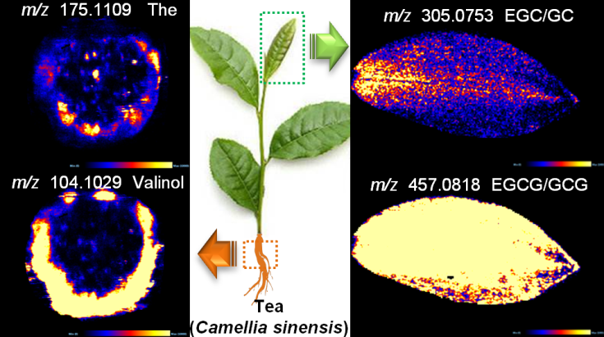
- 关于杨海滨研究员出访前的公示-美国09/08
- 关于王瑛等同志出访后的公示 马来西亚09/08
- 关于曾宋君研究员等二人出访后的公示-马来西亚09/08
- 关于李建雄研究员出访后的公示-法国09/08
- 关于王瑛研究员出访后的公示-英国09/08
- 关于推荐杨子银同志为第六届中国科技工作者协会会员人选的公示09/08
- 关于王瑛研究员出访前的公示-美国09/07
- 关于推荐侯兴亮研究员为2018年政府特殊津贴候选人的公示09/08 更多...
- 电话:020-37085863
- 传真:020-37092001
- 邮箱:chenmeifang@scbg.ac.cn
- 地址:广州市天河区兴科路723号综合楼303室
- 邮编:510650
茶叶中丰富与独特的代谢产物赋予其独有的色、香、味品质,而且与人体健康密切相关。因此研究这些代谢产物在茶树中的生物合成具有重要的意义。然而,由于茶树是非模式植物,且尚无成功的遗传转化体系,因此很难获得茶树中特征性代谢产物在茶树自身生物合成的直接证据,尤其在组织内和细胞水平的定位与分布信息。项目组建立了质谱成像的无损伤技术对茶树叶片和根系组织中特征代谢物的空间分布进行了分析(Food Chemistry, 2019, 292: 204-210)。不同种类的儿茶素在叶片组织内的分布不同;茶氨酸在根的表面韧皮部和中心木质部中分布。研究结果将有助于获得茶树中特征性代谢物质在自身生物合成的直接证据,同时也为其他非模式植物的次生代谢物质在组织内水平的可视化研究提供了借鉴。
Although specialized metabolite distributions in different tea tissues has been studied extensively, little is known about their within-tissue distribution owing to the lack of nondestructive methodology. In this study, desorption electrospray ionization imaging mass spectrometry was used to investigate the within-tissue spatial distributions of specialized metabolites in tea. To overcome the negative effects of the large amount of wax on tea leaves, several sample preparation methods were compared, with a Teflon-imprint method established for tea leaves. Polyphenols are characteristic metabolites in tea leaves. Epicatechin gallate/catechin gallate, epigallocatechin gallate/gallocatechin gallate, and gallic acid were evenly distributed on both sides of the leaves, while epicatechin/catechin, epigallocatechin/gallocatechin, and assamicain A were distributed near the leaf vein. L-Theanine was mainly accumulated in tea roots. L-Theanine and valinol were distributed around the outer root cross-section. The results will advance our understanding of the precise localizations and in-vivo biosyntheses of specialized metabolites in tea.
